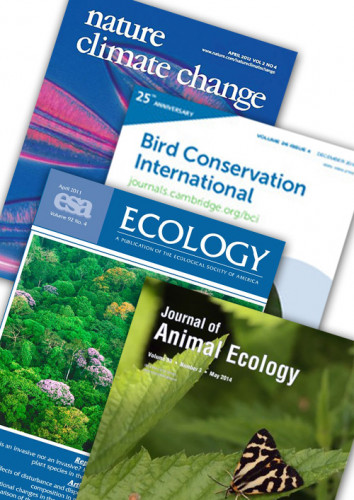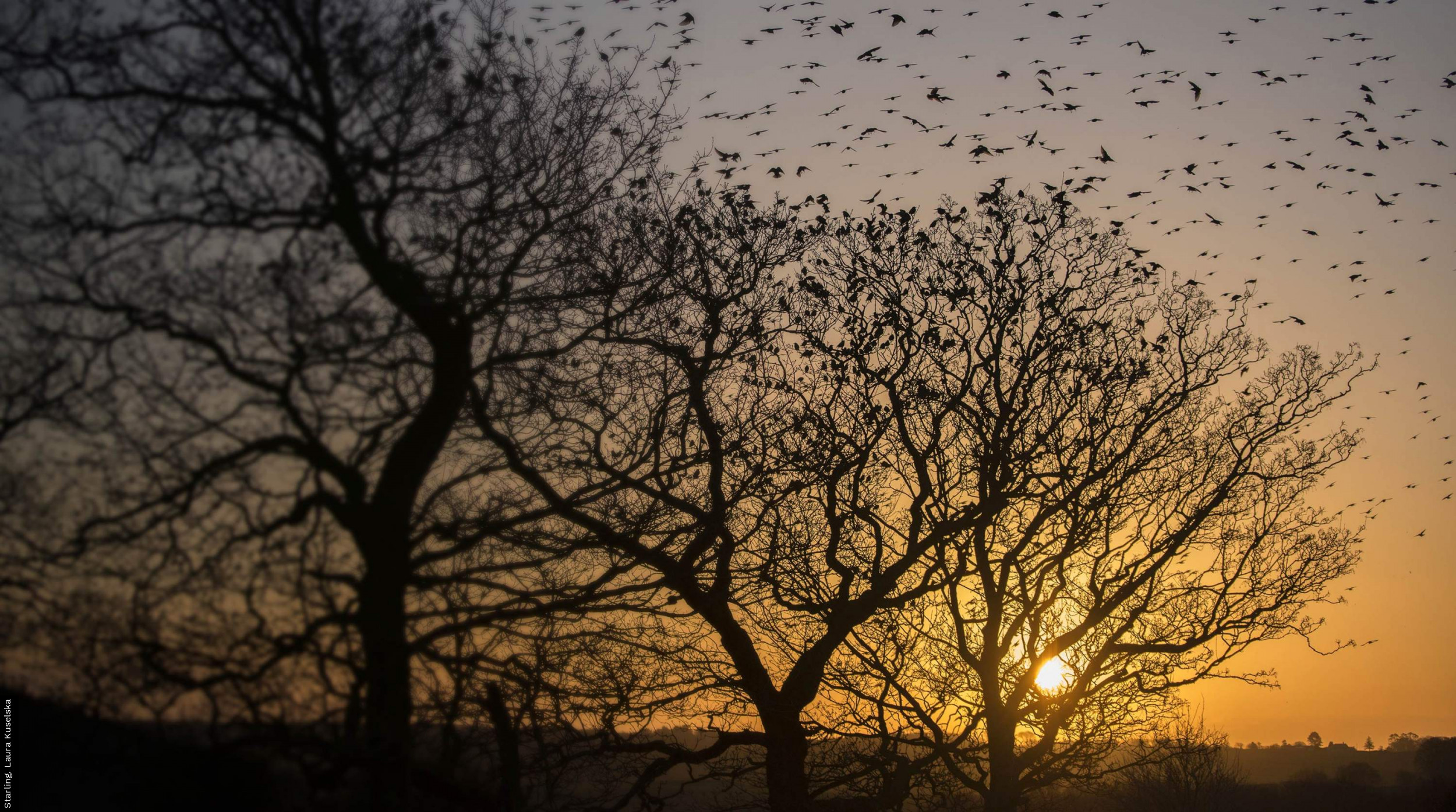Peer-reviewed papers

It is BTO’s policy to make public the results of our research. Our aim is to publish as much as possible of our work in the peer reviewed scientific literature. Many results are also published in our BTO Research Report series.
2019.
Population estimates of wintering waterbirds in Great Britain.
British Birds
112
: 130-145
View Abstract
2019.
Weak effects of geolocators on small birds: a meta‐analysis controlled for phylogeny and publication bias.
Journal of Animal Ecology
View Abstract
Link to Article (DOI: 10.1111/1365-2656.12962)
2019.
Effects of individual misidentification on estimates of survival in long-term mark–resight studies.
The Condor
121 (part 1)
View Abstract
Link to Article (DOI: 10.1093/condor/duy017)
2019.
The consequences of land sparing for birds in the United Kingdom.
Journal of Applied Ecology
Link to Article (DOI: 10.1111/1365-2664.13362)
2019.
Spatial and habitat variation in aphid, butterfly, moth and bird phenologies over the last half century
.
Global Change Biology
View Abstract
Link to Article (DOI: 10.1111/gcb.14592)
2019.
Habitat- and species-mediated short- and long-term distributional changes in waterbird abundance linked to variation in European winter weather..
Diversity and Distributions
25 (part 2)
: 225-239
View Abstract
Link to Article (DOI: 10.1111/ddi.12855)
2019.
Estimating age‐dependent survival from age‐aggregated ringing data—extending the use of historical records.
Ecology and Evolution
Link to Article (DOI: 10.1002/ece3.4820)
2019.
Advances in modelling demographic processes: The Euring 2017 Analytical Meeting.
Methods in Ecology and Evolution
Link to Article (DOI: 10.1111/2041-210X.13127)
2019.
Breeding populations of Little Ringed Plover Charadrius dubius and Ringed Plover Charadrius hiaticula in the United Kingdom in 2007.
Bird Study
Link to Article (DOI: 10.1080/00063657.2018.1563045)
2019.
Site-based adaptation reduces the negative effects of weather upon a southern range margin Welsh black grouse Tetrao tetrix population that is vulnerable to climate change.
Climatic Change
153
: 253-265
Link to Article (DOI: 10.1007/s10584-019-02372-2)
2019.
Exploring relationships between land use intensity, habitat heterogeneity and biodiversity to identify and monitor areas of High Nature Value farming.
Biological Conservation
231
: 30-38
Link to Article (DOI: 10.1016/j.biocon.2018.12.033)
2019.
Effects of tracking devices on individual birds – a review of the evidence.
Journal of Avian Biology
Link to Article (DOI: 10.1111/jav.01823)
2019.
The Scottish Raptor Monitoring Scheme: recent developments in good practice monitoring.
Bird Study
Link to Article (DOI: 10.1080/00063657.2018.1477737)
2019.
Declining population trends of European mountain birds.
Global Change Biology
25 (part 2)
: 577-588
View Abstract
Link to Article (DOI: 10.1111/gcb.14522)
2018.
A horizon scan of emerging issues for global conservation in 2019.
Trends in Ecology and Evolution
34 (part 1)
: 83-94
Link to Article (DOI: 10.1016/j.tree.2018.11.001)
2018.
Representing migration routes from re‑encounter data: a new method applied to ring recoveries of Barn Swallows (Hirundo rustica) in Europe.
Journal of Ornithology
160
: 249-264
View Abstract
Link to Article (DOI: 10.1007/s10336-018-1612-6)
2018.
Climate change vulnerability assessment of species.
WIREs Climate Change
10
Link to Article (DOI: 10.1002/wcc.551)
2018.
Spatio-temporal dynamics and aetiology of proliferative leg skin lesions in wild British finches.
Scientific Reports
8
Link to Article (DOI: 10.1038/s41598-018-32255-y)
2018.
Evaluating the effectiveness of conservation measures for European grassland‐breeding waders.
Ecology & Evolution
Link to Article (DOI: 10.1002/ece3.4532)
2018.
Spatial scales of marine conservation management for breeding seabirds
.
Marine Policy
98
: 37-46
Link to Article (DOI: 10.1016/j.marpol.2018.08.024)
2018.
When is enough enough? Effective sampling protocols for estimating the survival rates of seabirds with mark-recapture techniques.
Bird Study
Link to Article (DOI: 10.1080/00063657.2018.1516191)
2018.
An efficient survey method for estimating populations of marsh tits Poecile palustris, a low-density woodland passerine.
Bird Study
65 (part 3)
: 299-305
Link to Article (DOI: 10.1080/00063657.2018.1517243)
2018.
Effects of supplementary feeding on interspecific dominance hierarchies in garden birds.
PLOS ONE
13 (part 9)
Link to Article (DOI: 10.1371/journal.pone.0202152)
2018.
Habitat diversity and structure regulate British bird richness: Implications of non-linear relationships for conservation.
Biological Conservation
226
: 256-263
Link to Article (DOI: 10.1016/j.biocon.2018.08.010)
2018.
Implications of transformation to irregular silviculture for woodland birds: A stand wise comparison in an English broadleaf woodland.
Forest Ecology and Management
422
: 69-78
Link to Article (DOI: 10.1016/j.foreco.2018.04.004)
2018.
Large gulls taking fully grown shorebirds during spring passage in Delaware Bay, USA.
Wader Study
125 (part 2)
: 144-146
Link to Article (DOI: 10.18194/ws.00119)
2018.
Evaluating spatiotemporal trends in terrestrial mammal abundance using data collected during bird surveys.
Biological Conservation
226
: 153-167
Link to Article (DOI: 10.1016/j.biocon.2018.07.026)
2018.
Monitoring landscape-scale environmental changes with citizen scientists: Twenty years of land use change in Great Britain.
Journal for Nature Conservation
44
: 33-42
Link to Article (DOI: 10.1016/j.jnc.2018.03.001)
2018.
An assessment of the state of nature in the United Kingdom: A review of findings, methods and impact.
Ecological Indicators
94 (part 1)
: 226-236
Link to Article (DOI: 10.1016/j.ecolind.2018.06.033)
2018.
Quantifying avian avoidance of offshore wind turbines: Current evidence and key knowledge gaps.
Marine Environmental Research
140
: 278-288
Link to Article (DOI: 10.1016/j.marenvres.2018.06.017)
2018.
Habitat correlates of Eurasian Woodcock Scolopax rusticola abundance in a declining resident population.
Journal of Ornithology
: 1-11
Link to Article (DOI: 10.1007/s10336-018-1570-z)
2018.
Breeding ground correlates of the distribution and decline of the Common Cuckoo Cuculus canorus at two spatial scales.
Ibis
Link to Article (DOI: 10.1111/ibi.12612)
2018.
Overcoming the challenges of public data archiving for citizen science biodiversity recording and monitoring schemes.
Journal of Applied Ecology
55
: 2 544-2 551
Link to Article (DOI: 10.1111/1365-2664.13180)
2018.
Species contributions to single biodiversity values under-estimate whole community contribution to a wider range of values to society..
Scientific Reports
Link to Article (DOI: 10.1038/s41598-018-25339-2)
2018.
One hundred priority questions for landscape restoration in Europe.
Biological Conservation
221
: 198-208
Link to Article (DOI: 10.1016/j.biocon.2018.03.002)
2018.
Estimating mortality rates among passerines caught for ringing with mist nets using data from previously ringed birds..
Ecology and Evolution
Link to Article (DOI: 10.1002/ece3.4032)
2018.
Rapid progression of ash dieback in the coppice of Bradfield Woods, Suffolk.
Quarterly Journal of Forestry
2018.
Effects of winter food provisioning on the phenotypes of breeding blue tits.
Ecology and Evolution
Link to Article (DOI: 10.1002/ece3.4048)
2018.
Tritrophic phenological match-mismatch in space and time.
Ecology and Evolution
Link to Article (DOI: 10.1038/s41559-018-0543-1)
2018.
Spring migration strategies of Whinchat Saxicola rubetra when successfully crossing potential barriers of the Sahara and the Mediterranean Sea..
Ibis
Link to Article (DOI: 10.1111/ibi.12610)
2018.
Characteristics determining host suitability for a generalist parasite..
Scientific Reports
Link to Article (DOI: 10.1038/s41598-018-24627-1)
2018.
A review of raptor and owl monitoring activity across Europe: its implications for capacity building towards pan-European monitoring.
Bird Study
View Abstract
Link to Article (DOI: 10.1080/00063657.2018.1447546)
2018.
Covariation in urban birds providing cultural services or disservices and people..
Journal of Applied Ecology
Link to Article (DOI: 10.1111/1365-2664.13146)
2018.
Health hazards to wild birds and risk factors associated with anthropogenic food provisioning.
Philosophical Transactions of the Royal Society B
Link to Article (DOI: /10.1098/rstb.2017.0091)
2018.
Can climate matching predict the current and future climatic suitability of the UK for the establishment of non-native birds?.
Bird Study
65
: 72-83
Link to Article (DOI: 10.1080/00063657.2018.1438362)
2018.
The breeding population of Peregrine Falcon Falco peregrinus in the United Kingdom, Isle of Man and Channel Islands in 2014.
Bird Study
View Abstract
Link to Article (DOI: 10.1080/00063657.2017.1421610)
2018.
Using data from schools to model variation in soil invertebrates across the UK: The importance of weather, climate, season and habitat.
Pedobiologia
67
: 1-9
Link to Article (DOI: 10.1016/j.pedobi.2018.01.002)
2018.
Ecology and Conservation of Forest Birds.
Book title: Ecology and Conservation of Forest Birds
Cambridge University Press, Cambridge
2018.
Estimating national population sizes: Methodological challenges and applications illustrated in the common nightingale, a declining songbird in the UK.
Journal of Applied Ecology
55 (part 4)
: 2 008-2 018
Link to Article (DOI: 10.1111/1365-2664.13120)
2018.
Dodging the blades: new insights into three-dimensional space use of offshore wind farms by lesser black-backed gulls Larus fuscus.
Marine Ecology Progress Series
587
: 247-253
Link to Article (DOI: 10.3354/meps12415)



Share this page